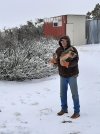Eskimos have 50 words for snow
Well,yes and no...It's more of a myth,actually...Here's a bit about that:
https://www.thecanadianencyclopedia.ca/en/article/inuktitut-words-for-snow-and-ice
But it's true in a way too,just like anywhere people live they learn to use the ins and outs of what surrounds them.
"Eskimos",Yupik and Inuit people live around the Arctic coastal plain.Much of their snow is pretty funky in texture-because of all the open,treeless landscape and constant wind the snow gets packed into this hard layer...As in hard to stomp your boot into.I worked up at Deadhorse one winter,and never could get over this wonderful effect,you can walk anywhere right on the surface of the snow.It's also constantly being carved by the wind into all sorts of waves and cornices and patterns...Way cool

.
Alaska is huge,much of it extends almost a 1000 miles south so far it becomes practically PNW,with it's warm/wet winter storms coming off the Japan current.
But the center of the state,so-called Interior Alaska,is yet different from the Panhandle(that southerly extension)and the Arctic and other coasts.
Interior Alaska is pretty much this one giant valley of the Yukon and Tanana rivers.It's heavily treed,and dry,and cold.Edged by two great mountain ranges,Brooks to the north(Rockies North),and Alaska range,it traps it's own weather systems.The mountains deflect much of the warmer cyclonic low-pressure centers,trapping the cold arctic air masses for weeks or months at a time.
So very dry,and often cold,and lots of trees to break the wind,make for our snow conditions.
Everything here is based on those snow particulars.The way people get around,everything you do in the winter.Animals,too of course are all totally dependent on the qualities of snow.
Many small critters run around underneath,some bigger ones fluff out in winter to have "snowshoes"-seriously furred pads to run around by staying on top of fairly loose/soft snow.
Yet bigger animals plow through with their lower legs(the hair there is very special,short and stiff).
Any changes are super critical,lets say for example if snow got any heavier,moose would starve as the amount of energy needed to get around would exceed what they can browse in a day....
And on and on,yes,the texture,depth,all that is very critical,and for someone being outdoors a lot,very important.You do catch yourself sometimes discussing the snow conditions with other people in embarrassing detail...


